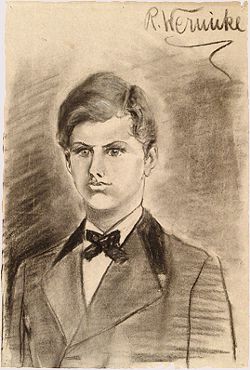Notes
- ↑ Lace, Ian (July 2002). "Review of Recording of Atterberg Symphonies 2 and 5". MusicWeb International. Retrieved 23 November 2007.
- ↑ Farrell, Sam (2000). "Biography of Ernst Bacon". Classical.net. Retrieved 22 June 2008.
- ↑ "Information about Recording of Bainton Symphony". Chandos Records . Retrieved 21 November 2007.
- ↑ Score at the International Music Score Library Project
- ↑ Score at the International Music Score Library Project
- ↑ "The Online Catalog of the Gemeinsamer Bibliotheksverbund (Joint Library Network)" (in German). Retrieved 22 December 2007.
- 1 2 3 "Boccherini Symphony Catalog at U. Quebec" . Retrieved 25 November 2007.
- ↑ "Henry Brant Worklist". Carl Fischer. Archived from the original on 13 March 2005. Retrieved 27 August 2008.
- ↑ "Permanent Link to Record for Bristow's 2nd symphony at New York Public Library" . Retrieved 27 August 2008.
- ↑ "Cornell Library Record for Krueger's Recording of Bristow's 2nd Symphony". 1969. Retrieved 27 August 2008.
- ↑ Fritz Brun: Symphony No. 3 OCLC 637915150
- ↑ Frisch 2003 , Table 1-1: "A chronological listing of symphonies by contemporary composers published in the Austro-German sphere in the period between Schumann's Third and Brahms's First". Dietrich's is listed under 1870 (its date of publication, as Frisch explains in a note on p. 10).
- ↑ Witte, Peter (31 March 2007). "Page about Dietrich's D minor Symphony" (in German). Klassika.info. Retrieved 22 December 2007.
- ↑ "Records International Description of Recording of Foerster Symphony 1". MD+G. April 2008. Retrieved 11 June 2008.
- ↑ Information at IMSLP.
- ↑ "British Symphonies on CD Page 1". MusicWeb International. 2007. Retrieved 23 November 2007.
- ↑ Sonneck 1912 , p. 168; see also the website of the Institut Théodore Gouvy.[ full citation needed ]
- ↑ Hans Huber: "Symphony No. 1 in D minor Op. 63 ‘Tell Symphony’", Musikproducktion Juergen Hoeflich.
- ↑ Hans Huber: Symphony No. 7 "Swiss" RISM 402004891 RISM]
- ↑ van Rijen, Onno (11 February 2007). "Janis Ivanovs". Archived from the original on 25 October 2007. Retrieved 23 November 2007.
- ↑ Tsalahouris, Philippos (2007). "Description of Kalomiris Third Symphony". Naxos Records. Retrieved 10 February 2008.
- ↑ Sonneck 1912, p. 247.
- ↑ "Samfundet Publication of Malling Symphony – Link in Cornell Catalog". 1884. Retrieved 27 August 2008.
- ↑ Schlüren, Christoph (2003). "Preface to score of Martucci First Symphony". Musikproducktion Juergen Hoeflich. Retrieved 24 August 2020.
- 1 2 "The English Symphony 1880–1920". Musical Resources UK. 2007-03-25. Archived from the original on 28 June 2007. Retrieved 21 November 2007.
- ↑ Sonneck 1912, p. 324.
- ↑ Sonneck 1912, p. 343.
- ↑ Leichting, Avrohom (2007). "Online Publication of Preface to Score of Raff Symphony No. 6 (Reprinted from Musikproduktion Höflich with permission)" . Retrieved 24 August 2020.
- ↑ "Rheinberger Chronology". Carus-Verlag. Archived from the original on 27 February 2009. Retrieved 18 November 2007.
- ↑ Barnett, Rob (February 2007). "Review of Recording of Ries' Symphonies". MusicWeb International. Retrieved 22 November 2007.
- ↑ Lewis, Dave. "Description of Concerto Köln Recording of Rigel Symphonies". Allmusic. Retrieved 14 August 2009.
- ↑ Robinson, Bradford (2004). "Online publication of preface to score of Rubinstein D minor Symphony". Musikproduktion Juergen Hoeflich. Retrieved 24 August 2020.
- ↑ "Recording of All Salmanov's Symphonies". Records International. September 2005. Retrieved 10 February 2008.
- ↑ Bergmans, Charles (1901). Le Conservatoire Royal de musique de Gand: étude sur son histoire et son organisation at Google Books. Gand: G. Beyer. OCLC 23413212. Page 379.
- ↑ "Permanent Link to Library of Congress Card". Breitkopf und Härtel. Retrieved 10 June 2008..
- ↑ Sonneck 1912, p. 409.
- ↑ Weiermüller-Backes, Isolde (2006-01-28). "Page Listing Senfter's 2nd Symphony". Klassika.info. Retrieved 22 December 2007.
- ↑ "Sinding Werkverzeichnis" (in German). Klassika.info. Retrieved 22 December 2007.
- ↑ Barnett, Rob (August 2007). "Review of Hyperion Recording of Spohr Symphonies 1 and 2". MusicWeb International. Retrieved 10 February 2008.
- ↑ Lewis Foreman (1991). "Booklet accompanying recording of Stanford 2nd Symphony" (PDF). Chandos Records. Retrieved 21 November 2007.
- ↑ "Description of Strauss D minor Symphony" (in German). Klassika.info. 14 January 2006. Retrieved 22 December 2007.
- ↑ "Announcement of Recording of Suter's Symphony" (in German). 2004. Retrieved 10 June 2008.
- ↑ Nice, David (2007). "Notes to recording of Taneyev Symphonies 1 and 3" (PDF). Chandos Records. Archived from the original (PDF) on 26 May 2011. Retrieved 22 December 2007.
- ↑ Bryan, ed.: Vanhal – Six Symphonies at Google Books, page xvi.
- ↑ Bryan, Paul. "Description of Recording of Wanhal's Symphony d2". Naxos Direct. Retrieved 22 June 2008.
- ↑ "Heckenast Parts Edition of Volkmann, published in 1863" . Retrieved 24 August 2020.
- ↑ "Karl Weigl Papers". Irving S. Gilmore Music Library of Yale University. Archived from the original on 10 September 2007. Retrieved 21 November 2007.
- ↑ Frisch 2003, p. 9.
- ↑ "Alexander Zemlinsky: Vienna 1884–1892". www.zemlinsky.at. Retrieved December 31, 2010.
- ↑ "Johann Christoph Friedrich Bach" in Nolte, Ewald V., ed., Four Early Sinfonias at Google Books. Dates based on early copies by Johann Friedrich Peter. Madison, Wis.: A-R Editions, 1982. Preface page xi. ISBN 0-89579-170-6. OCLC 9203471.
Sources
- Frisch, Walter (2003). Brahms: The Four Symphonies. New Haven: Yale University Press. pp. 7–10. ISBN 0-300-09965-7.
- Sonneck (1912). Orchestral Music (Class M1000-1268) Catalogue. Library of Congress, Music Division.[ clarification needed ]



